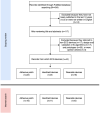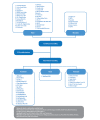Electrocardiogram Devices for Home Use: Technological and Clinical Scoping Review
- PMID: 37418308
- PMCID: PMC10362423
- DOI: 10.2196/44003
Electrocardiogram Devices for Home Use: Technological and Clinical Scoping Review
Abstract
Background: Electrocardiograms (ECGs) are used by physicians to record, monitor, and diagnose the electrical activity of the heart. Recent technological advances have allowed ECG devices to move out of the clinic and into the home environment. There is a great variety of mobile ECG devices with the capabilities to be used in home environments.
Objective: This scoping review aimed to provide a comprehensive overview of the current landscape of mobile ECG devices, including the technology used, intended clinical use, and available clinical evidence.
Methods: We conducted a scoping review to identify studies concerning mobile ECG devices in the electronic database PubMed. Secondarily, an internet search was performed to identify other ECG devices available in the market. We summarized the devices' technical information and usability characteristics based on manufacturer data such as datasheets and user manuals. For each device, we searched for clinical evidence on the capabilities to record heart disorders by performing individual searches in PubMed and ClinicalTrials.gov, as well as the Food and Drug Administration (FDA) 510(k) Premarket Notification and De Novo databases.
Results: From the PubMed database and internet search, we identified 58 ECG devices with available manufacturer information. Technical characteristics such as shape, number of electrodes, and signal processing influence the capabilities of the devices to record cardiac disorders. Of the 58 devices, only 26 (45%) had clinical evidence available regarding their ability to detect heart disorders such as rhythm disorders, more specifically atrial fibrillation.
Conclusions: ECG devices available in the market are mainly intended to be used for the detection of arrhythmias. No devices are intended to be used for the detection of other cardiac disorders. Technical and design characteristics influence the intended use of the devices and use environments. For mobile ECG devices to be intended to detect other cardiac disorders, challenges regarding signal processing and sensor characteristics should be solved to increase their detection capabilities. Devices recently released include the use of other sensors on ECG devices to increase their detection capabilities.
Keywords: ECG clinical validation, ECG technical characteristics; electrocardiogram; home use ECG; medical devices; mobile ECG; wearables.
©Alejandra Zepeda-Echavarria, Rutger R van de Leur, Meike van Sleuwen, Rutger J Hassink, Thierry X Wildbergh, Pieter A Doevendans, Joris Jaspers, René van Es. Originally published in JMIR Cardio (https://cardio.jmir.org), 07.07.2023.
Conflict of interest statement
Conflicts of Interest: PAD is cofounder of HeartEye BV. All other authors declare no other conflicts of interest.
Figures



References
-
- Cardiovascular diseases (CVDs) World Health Organization. 2021. Jun, [2021-06-04]. https://www.who.int/en/news-room/fact-sheets/detail/cardiovascular-disea...
-
- Roth GA, Forouzanfar MH, Moran AE, Barber R, Nguyen G, Feigin VL, Naghavi M, Mensah GA, Murray CJ. Demographic and epidemiologic drivers of global cardiovascular mortality. N Engl J Med. 2015 Apr 02;372(14):1333–41. doi: 10.1056/NEJMoa1406656. https://europepmc.org/abstract/MED/25830423 - DOI - PMC - PubMed
-
- Meek S, Morris F. ABC of clinical electrocardiography. introduction. I-leads, rate, rhythm, and cardiac axis. BMJ. 2002 Feb 16;324(7334):415–8. doi: 10.1136/bmj.324.7334.415. https://europepmc.org/abstract/MED/11850377 - DOI - PMC - PubMed
-
- Hall ME, Hall JE, Guyton A. Fundamentals of electrocardiography. In: Hall JE, editor. Guyton and Hall Textbook of Medical Physiology. 14th edition. Philadelphia, PA, USA: Saunders; 1956. pp. 135–41.
Publication types
LinkOut - more resources
Full Text Sources

